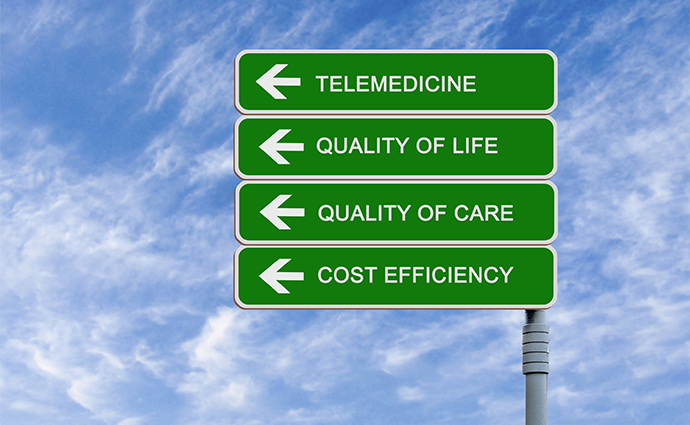CMS: 9 Million Used Telehealth During Early Days of COVID-19
In a commentary in Health Affairs, CMS Administrator Seema Verma laid out the numbers for telehealth use by Medicare beneficiaries from March through June, and said the agency is still working on a plan for long-term coverage.

Source: ThinkStock
- More than 9 million Medicare beneficiaries used telehealth during the early stages of the coronavirus pandemic, according to data from the Centers for Medicare & Medicaid Services, with a weekly jump in virtual visits from 13,000 pre-pandemic to almost 1.7 million in April.
The information, contained in a July 15 Health Affairs commentary penned by CMS Administrator Seema Verma, points to the rapid uptake of connected health use from March 17 through June 30, spurred by the crisis and state and federal efforts to relax telehealth rules to encourage adoption. It also comes as healthcare providers await information from CMS as to how these temporary measures might be made permanent.
“Telehealth will never replace the gold-standard, in-person care, (but it does serve) as an additional access point for patients, providing convenient care from their doctor and health care team and leveraging innovative technologies that could improve health outcomes and reduce overall health care spending,” Verma said. “The rapid explosion in the number of telehealth visits has transformed the health care delivery system, raising the question of whether returning to the status quo turns back the clock on innovation.”
“The data have shown that telehealth can be an important source of care across the country, not just for those living in rural areas,” she added. “Additionally, the immediate uptake in telehealth demonstrates the agility of the health care system to quickly scale up telehealth services, so that health care providers can safely take care of their patients while avoiding unnecessary exposure to the virus.”
According to that data, compiled from Medicare FFS claims:
- Some 22 percent of telehealth beneficiaries in rural areas used telehealth during that time frame, while 30 percent of urban beneficiaries sought virtual care;
- More than 35 percent of beneficiaries in the Northeast – specifically, Massachusetts, Rhode Island, Connecticut, New Jersey, Delaware and Maryland – used telehealth, compared to less than 17 percent telehealth use among beneficiaries in Nebraska, Montana, Idaho and the Dakotas;
- One-quarter of all male beneficiaries accessed telehealth during the time period, while 30 percent of female beneficiaries used it;
- Some 34 percent of people between below age 65 used telehealth, a higher rate than those between the ages of 65 and 74 (25 percent) and 75 and 84 (29 percent), as well as those over 85 (28 percent);
- Some 28 percent of people identifying themselves as white access telehealth, while 25 percent of Asians, 29 percent of Blacks, 27 percent of Hispanics and 26 percent of those identifying as “other” used connected health;
- Roughly 34 percent of dual-eligible beneficiaries used telehealth, compared to 26 percent of those only on Medicare, with use spread evenly over racial and ethnic groups;
- The most common form of connected health visit was the evaluation and management (E/M) visit, used by nearly 5.8 million beneficiaries, and 38 percent of those visits conducted on a telemedicine platform;
- Some 460,000 beneficiaries received telemental health care during this time;
- Some 26 percent of beneficiaries received nursing home visits via telehealth;
- Roughly 19 percent of the 1.5 million beneficiaries who access preventive health services during this time period used telehealth; and
- More than 3 million beneficiaries access care through an audio-only phone, roughly one-third of the total number using telehealth during this time.
READ MORE: Senators Ask HHS, CMS for Telehealth Expansion Timeline, Details
Looking to the future, Verma said CMS is “reviewing the temporary changes we made and assessing which of these flexibilities should be made permanent through regulatory action,” which CMS officials have said will likely be posted in the Federal Register sometime this month. To that end, the agency is focusing on three issues:
- Whether the telehealth service is safe and clinically appropriate for patients – for example, whether telehealth can be used as a first point of contact between a doctor and patient, as opposed to the pre-COVID-19 standard of requiring an in-person visit first.
- Whether Medicare should reimburse for telehealth services at the same rate as it does for in-person services. “Further analysis could be done to determine the level of resources involved in telehealth visits outside of a public health emergency, and to inform the extent to which payment rate adjustments might need to be made,” Verma noted. “For example, supply costs that are typically needed to enable safe in-person care (for, e.g., patient gowns, cleaning, or disinfectants) and built into the in-person payment rate are not needed in a telehealth visit. On the other hand, there are new processes that clinicians must create for telehealth visits, with associated costs.”
- How these services might be used for fraudulent activities, such as practitioners who bill for more visits than they’re conducting or who are shortening their telehealth visits while still billing for the maximum payment.
“With these transformative changes unleashed over the last several months, it’s hard to imagine merely reverting to the way things were before,” Verma said. “As the country re-opens, CMS is reviewing the flexibilities the administration has introduced and their early impact on Medicare beneficiaries to inform whether these changes should be made a permanent part of the Medicare program.”
